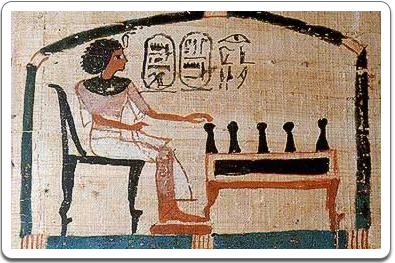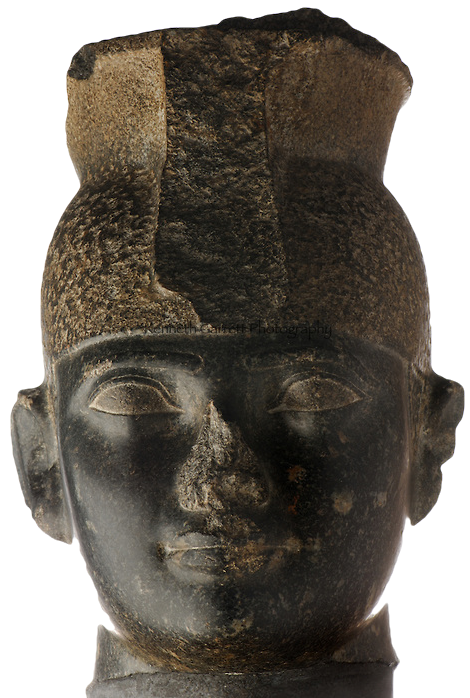In most history books, the period following the New Kingdom is the 3rd Intermediate Period (1070 - 712 or 1070 - 525), composed of the dynasties 21 through 24 or 26. This period, followed by the Late Period (712 - 332 or 525 - 332), is often described as a period of decline and chaos.
It is true that during most of the so-called 3rd Intermediate Period, there was more than one centre of power in Egypt: in Tanis, in the Nile Delta, there were the kings from the 21st and 22nd Dynasty, who nominally ruled the entire country, but who had to share their power with the Theban high-priests, or with some other, local dynasties, such as the 23rd and the 24th. This division of power, however, did not lead to civil wars or a decline in wealth.
To the contrary, the period so often called "3rd Intermediate Period" was a period of relative peace and stability. The 21st Dynasty royal tombs, unearthed in Tanis, are among the richest finds in the history of Egyptian archaeology. That the power did not only reside with the king and his entourage, was the result of the increasing wealth of private persons, such as the Theban high-priests. This too is echoed by the immense private tombs found on the Theban West Bank, dated to this period. I have therefore chosen not to use the name "3rd Intermediate Period" and have the Late Dynastic Period immediately follow the New Kingdom.
During most of the New Kingdom, the wealth and power of the Theban high-priests had slowly increased. It is possible that 18th Dynasty King Akhenaton’s Amarna-revolution was a -failed- attempt to break this power.
At the end of the New Kingdom, during the later years of Ramesses XI, a Theban high-priest named Herihor, possibly a brother-in-law to Ramesses XI, was able to combine his influential office with the office of vizier and he bore the honorary title of "viceroy of Kush". He was so wealthy that he was able to build parts of the Khonsu-temple in Karnak and he even usurped the royal privilege to have his name written in a cartouche! When Ramesses XI died, the dynasty of high-priests had become a major political factor.

Towards the end of the 20th Dynasty, the Theban high priest of Amun had gained so much political influence that he was able to usurp several royal privileges.
The kings of the 21st Dynasty were probably related through marriage to the last Ramessides. They moved the capital from Pi-Ramesse to Tanis, both in the Nile Delta, probably because the canal neighbouring Pi-Ramesse had dried out. At Tanis they launched an elaborate building activity, one that was to rival the temple of Amun in Thebes and which also included the moving of temples and palaces from the old capital Pi-Ramesse to Tanis. They also moved the royal necropolis from the Valley of the Kings on the Theban West Bank to Tanis, where the intact tomb of Psusennes I has been discovered in the late 1930’s.
Statue of Queen Karomama, wife of 22nd Dynasty King Osorkon II.
Another important political factor was the Libyan military, which had been integrated into the Egyptian army and police force during the late New Kingdom. At the end of the 21st Dynasty, one of those leaders, who was married to the daughter of the last king of the 21st Dynasty, came to power. He founded a new dynasty, the 22nd, also called the Libyan or the Bubastide Dynasty since the Dynasty was founded by Libyans who lived in the Delta-city of Bubastis. The early Bubastide kings were powerful rulers who were able to re-establish Egyptian presence in Syria-Palestine. They were also able to determine who would be high-priest in Thebes and they often picked someone from their own family, thus reinforcing the Egyptian unity.
But dynastic rivalry would soon bring an end to the newly found unity. In Leontopolis, also in the Delta, a 23rd Dynasty was proclaimed. This example would soon be followed by Tefnakht, a prince in the Delta-city of Sais, who founded the 24th Dynasty. Not only was Egypt divided between the Delta and Thebes, now the Delta itself would be divided as well.
Taking advantage from these internal conflicts, a new power arose in the South, in Nubia. There a dynasty had come to power intent on conquering Egypt. In an effort to confront this Nubian invasion, the three Delta-dynasties allied themselves, but they were defeated. The 25th Dynasty would be a Nubian or Kushite Dynasty. The monarchs of the 25th Dynasty ruled the larger part of Egypt -only the 24th Dynasty from Sais seems to have maintained its independence- from their own capital, Napata, near the 4th cataract, but they would rule it following the old Egyptian traditions.

Head of a statue of the Nubian King Taharqa, who ruled Egypt during the 25th Dynasty.
The peace and stability resulting from the Nubian conquest was brought to an end by another external factor: the Assyrians. Although the presence of the Assyrians in Egypt has been a short one, its results were devastating. The once glorious Thebes was plundered, ransacked and many wonderful temples, among which the mortuary temple of Ramesses II, were destroyed.
Fortunately for Egypt, the Assyrians were forced to return to Assur, leaving the king of Sais, Psamtek I, the opportunity to take control of the entire country. With him began the 26th Dynasty and a new era of stability and prosperity in Egypt. For more than a century, the 26th Dynasty would rule over Egypt, until it was defeated by Persian invaders.
The latter part of the Late Dynastic Period starts and ends with a Persian occupation. The first Persian occupation, also known as the 27th Dynasty, lasted for more than a century. It was brought to an end by Amyrtaios, the only king of the 28th Dynasty, who succeeded in ridding Egypt of the Persian yoke and was able to re-establish control over the entire country.
Egypt’s regained independence lasted some 60 years, during which the kings of the 29th and 30th Dynasties ruled the country and re-established all of its traditions.
The 2nd Persian occupation would only last for 101years, but it was one of the darkest pages in the history of Ancient Egypt: temples were plundered, holy animals were butchered and the people were subjected to demanding tributes. Egypt’s ordeal during this occupation would make it ready to welcome the Macedonian king Alexander the Great as its liberator.
With the conquest of Egypt by Alexander, Egypt would become a Hellenistic state and a new era had begun.
Click the thumbnails below to learn more about the dynasties of the Late Dynastic Period: